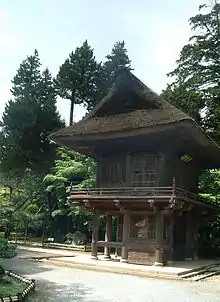Heirin-ji
| Heirin-ji | |
|---|---|
金鳳山平林寺 | |
 Front gate at Heirinji | |
| Religion | |
| Affiliation | Rinzai |
| Deity | Shaka Nyorai |
| Location | |
| Location | 3-1-1 Nobidome, Niiza-shi, Saitama-ken |
| Country | Japan |
| Architecture | |
| Founder | Sekishitsu Zenkyū |
| Completed | 1375 |
| Website | |
| Official website (in Japanese) | |
Heirin-ji (平林寺) is a Rinzai temple of the Myoshin-ji branch located in Niiza city, Saitama prefecture, Japan, a city just outside Tokyo.
History
The temple was founded in Iwatsuki, Saitama in 1375 by Sekishitsu Zenkyū, who had served as the Abbot of Engaku-ji, Tenryū-ji and Shōfuku-ji.[1] During this period the original temple was destroyed in 1590 during an attack on Iwatsuki Castle by Toyotomi Hideyoshi.
It was rebuilt in 1603 by Tokugawa Ieyasu and moved to Niiza city sixty years later. The temple grounds are situated in a forested area and is considered to be a national monument. Heirin-ji differs from other temples in the Tokyo area by having no temple markets nor public festivals held at the temple.
The temple remains a training temple for monks, who can often be seen working in the grounds. The grounds of the temple preserve a stretch of the Musashino woodlands. Animals such as raccoon dogs that are now not often seen in the city are found around the temple. The grounds also provide a roost for a large murder of Japanese crows. The gardens are notable for the maple trees in autumn and the ume blossoms in early spring. The bell, with the ume blossom, was the inspiration for one of Toshi Yoshida's wood block prints.[2][3]
See also
- For an explanation of terms concerning Japanese Buddhism, Japanese Buddhist art, and Japanese Buddhist temple architecture, see the Glossary of Japanese Buddhism.
Gallery
Notes
- "石室善玖とは - コトバンク".
- Watanabe, 39
- McDonagh
References
- Hiroshi Watanabe (2001). The Architecture of Tokyo. Edition Axel Menges. ISBN 3-930698-93-5.
- McDonagh, Michael. "Now and Zen". Metropolis. Archived from the original on 22 December 2007. Retrieved 20 January 2008.






